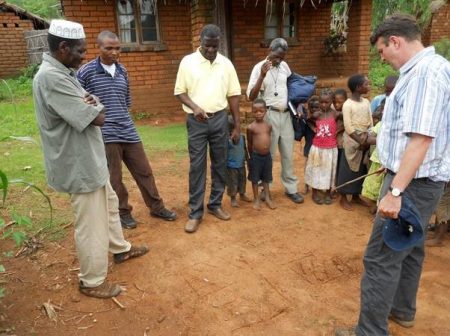
LIWONDE, Malawi (CIMMYT) — Esnath Shaibu, a smallholder farmer from Matandika, southern Malawi was a host farmer with the International Maize and Wheat Improvement Center (CIMMYT) for seven years who helped the organization conduct research trials on sustainable agriculture intensification with support from the International Fund for Agricultural Development (IFAD).
Shaibu’s farm in Matandika, like most other farms in this area, is small and restricted to less than one hectare (ha) per household. Matandika is highly affected by the effects of climate change and a growing population is putting more pressure on dwindling land resources. Farmers have experienced more droughts in recent years which has affected food and nutritional security. Investment into soil conservation and maintaining soil fertility has therefore become critical.
A good proportion of Shaibu’s livelihood is generated from the land of his .3 ha research plot, which evaluates conservation agriculture (CA) systems in the environments and circumstances of Matandika.
The fields in Matandika are on hillsides and need to be seeded with as little disturbance as possible to avoid soil erosion and run-off. Farmers have also understood the value of crop residues and integrate legumes as intercrops in their fields to intensify their farming systems and increase diversification. Optimal plant spacing, early planting and precision application of fertilizers have been other good agriculture practices that farmers perfected in this area.
During the trials, Shaibu practiced a direct seeded CA method, intercropping maize and pigeonpea, and compared the results with conventional tillage practices just planting maize. Yields from Shaibu’s plots were increasingly stable under the CA system, as they proved to be more resilient against in-season dry-spells, drought and unevenly disturbed rainfalls which often fell at great intensity.
Shaibu graduated from the CA program in 2014, but continued to implement the same principles and practices on his own without CIMMYT’s interference or support.
When questioned about his rationale during a field visit in 2017, Shaibu said “we saw something good in it,” and his healthy looking crop spoke for itself.
Shibu’s case demonstrates that technology adoption is only successful if we as development practitioners work ourselves out of a job. He is a true adopter who has continued investing his own resources to produce a good maize crop on a significant proportion of his land by applying CA principles at highest standards. Shaibu has also converted other fields he owns to CA and continues to be an influential advocate in the community for the benefits of CA.
 Capacity development
Capacity development 
